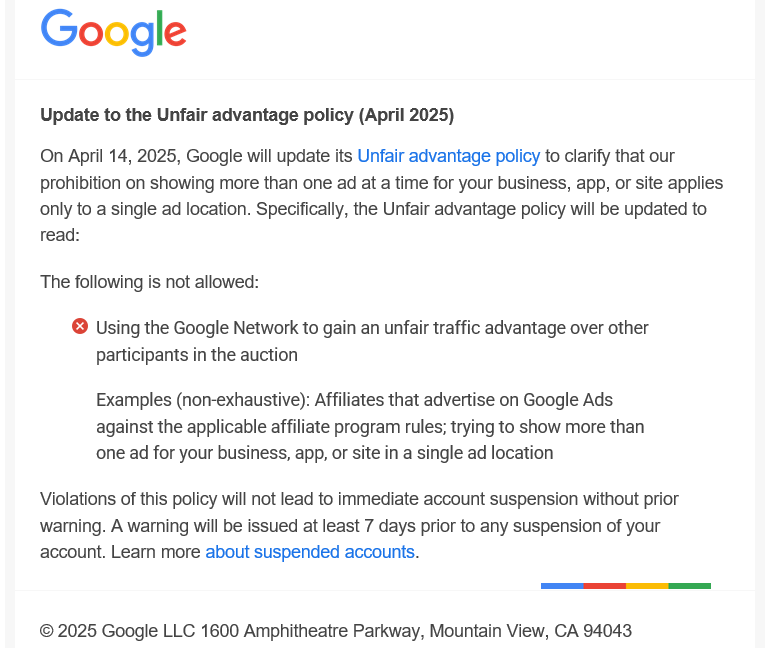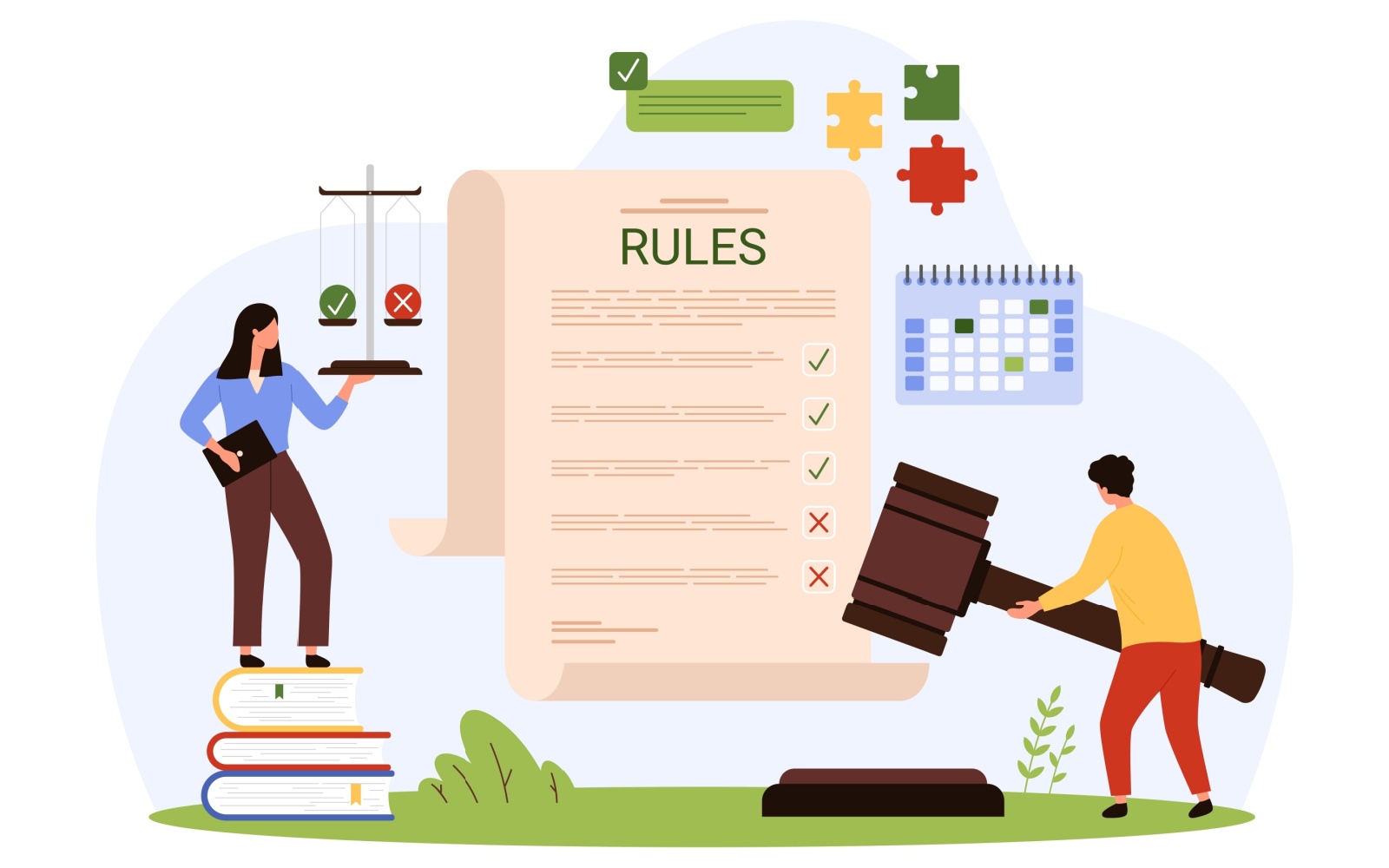On Friday, Google sent out a subtle but impactful policy update to advertisers, confirming changes to its long-standing “Unfair Advantage Policy”.
While the official enforcement date is April 14, 2025, the conversation has already started — and it’s anything but quiet.
The PPC community is buzzing with opinions, questions, and concerns. But this update didn’t come out of nowhere.
About a month ago, Google quietly laid the groundwork for this change without most people noticing.
Let’s unpack exactly what’s happening, why it matters, and how advertisers are reacting.
What Did Google Change?
The core of the update is about limiting how many ads a business, app, or site can show in a single ad location. Here’s Google’s new language:

The new language is crucial to understand.
The focus isn’t on restricting brands from showing multiple ads across different placements—it’s about stopping advertisers from stacking multiple ads in the same slot, which would effectively block competition and inflate dominance.
It’s not a total ban on multiple ads from the same advertiser showing on a single page, but rather a limit within a specific ad location.
However, as with many Google Ads policies, the phrase “single ad location” is doing a lot of heavy lifting—and advertisers are left wondering how Google will interpret and enforce it in practice.
One notable detail: Google says violations won’t lead to instant account suspensions. Advertisers will receive a warning and at least seven days to address any violations before facing suspension.
This is important. Google seems to be trying to strike a balance between tightening policy and giving advertisers room to adapt.
The Breadcrumb Many Missed – February Auction Documentation Update
Interestingly, this isn’t the first time Google has hinted at this shift.
Back in February 2025, advertisers noticed that Google updated its documentation on “How the Google Ads Auction Works”.
The update clarified that Google runs separate auctions for each ad location, meaning that the auction for the first position is distinct from the auction for the second, third, and so on.
Ginny Marvin, Google Ads Liaison, even acknowledged the change directly in LinkedIn discussions. This detail flew under the radar for many but now seems like a foundational piece for this official Unfair Advantage update.

Effectively, Google was setting the table a month ago. This policy update simply formalizes how those auctions will now prevent advertisers from “double-serving” or stacking ads in the same position.
Why Google Is Doing This, And Why Now
Google’s goal here appears twofold:
-
Auction Fairness — Google wants to prevent scenarios where advertisers, affiliates, or large multi-account setups game the system by occupying multiple positions within a single auction.
-
Affiliate Abuse Control — This rule directly calls out affiliates who break affiliate program rules, a growing concern in Google’s search ecosystem.
Of course, some advertisers suspect there’s a third goal: protecting the user experience and, more directly, protecting Google’s own long-term revenue by encouraging more advertisers to compete rather than allowing the largest players to squeeze others out.
Advertisers Give Mixed Reactions to Google Update
While this update was emailed to advertisers on Friday afternoon, marketers didn’t waste time sharing their takes on the update.
Andrea Atzori, who also received the email from Google, took to LinkedIn to provide his take on the update.
Atzori highlighted that this change is more about clarification than transformation, as he’d seen the same advertiser in multiple locations previously.
Navah Hopkins also took to LinkedIn with a more brief update, eager to hear thoughts from fellow marketers on the Unfair Advantage policy.
Hopkins and others noted that while the update may sound fair in theory, the proof will come in how it affects impression share, Auction Insights, and real-world campaign performance.
From the comments on Hopkin’s post, early reactions seem to lead towards skepticism and questions:
Chris Chambers commented:
This is going to be wild from a metric reporting standpoint since it seems like right now it counts as 2 impressions and also affects your impression share and position in Auction Insights (same with competitors).
But it also seems like now the advertisers with the most to spend in each niche will get even more real estate and be able to show twice, potentially cutting out smaller competitors completely from the first page.
Steve Gerencser had a similar take to Chambers:
I wonder how they are going to count people that pogo from one ad right back to the next and then back to something else? I can see a lot of wasted ad spend, or an opportunity for someone with deep pockets to dominate.
Some worry that well-funded advertisers will still find ways to dominate, while smaller brands hope this levels the playing field.
What Advertisers Should Watch For
While the policy may not seem earth-shattering at first glance, it does come with a few things advertisers should actively monitor.
First, smaller and mid-sized advertisers may stand to benefit, at least in theory. By limiting how many ads a single business can show in one location, Google could slightly reduce the dominance of big-budget brands that have historically owned the top of the page through multiple placements.
This could open up space for other players to get visibility where previously they were pushed out.
But, as several PPC pros pointed out on LinkedIn, the big question is how Google defines and enforces a single ad location in practice.
Google clarified last month that each ad location runs its own auction, meaning it’s technically possible for a brand to show up in multiple places on the same page—just not in the exact same slot.
So, while the policy aims to limit dominance, it doesn’t necessarily mean fewer total appearances for advertisers with deep pockets.
This also has potential ripple effects on Auction Insights reports. If Google starts filtering or limiting how often multiple ads from the same business appear in a given location, expect impression share metrics and overlap rates to behave differently—maybe even unexpectedly.
Advertisers will need to watch Auction Insights and Impression Share trends closely post-April to see if any patterns emerge.
Additionally, affiliate marketers and businesses using aggressive multi-account or multi-site strategies should be especially careful. The updated policy makes it clear that affiliates must play by their program’s rules and can no longer try to sneak multiple ads for the same offer into the same auction.
While Google says you’ll get a warning before any suspension, it’s probably wise to get ahead of this now, rather than risk a compliance issue later.
And finally, there’s still some ambiguity about multi-brand or franchise setups. If you’re managing a brand with multiple sub-brands, sister companies, or franchisees, the question remains: will Google treat you as one business under this policy or multiple?
That detail could make a big difference, especially for large organizations or verticals like automotive, real estate, or hospitality.
Final Thoughts: Is This Really a Game-Changer?
Honestly? It’s hard to call this a monumental shift yet. The update feels more like a formalization of existing enforcement patterns than a radical new rulebook.
That said, the PPC community is right to question what this will look like in Auction Insights and daily performance reports. Whether this is a minor tweak or the start of stricter anti-duplication policing will become clearer as advertisers see real-world data throughout Q2 and beyond.
Either way, it’s worth watching—especially if you’ve ever benefitted from, or competed against, someone taking up too much SERP real estate.





![AI Overviews: We Reverse-Engineered Them So You Don't Have To [+ What You Need To Do Next]](https://www.searchenginejournal.com/wp-content/uploads/2025/04/sidebar1x-455.png)